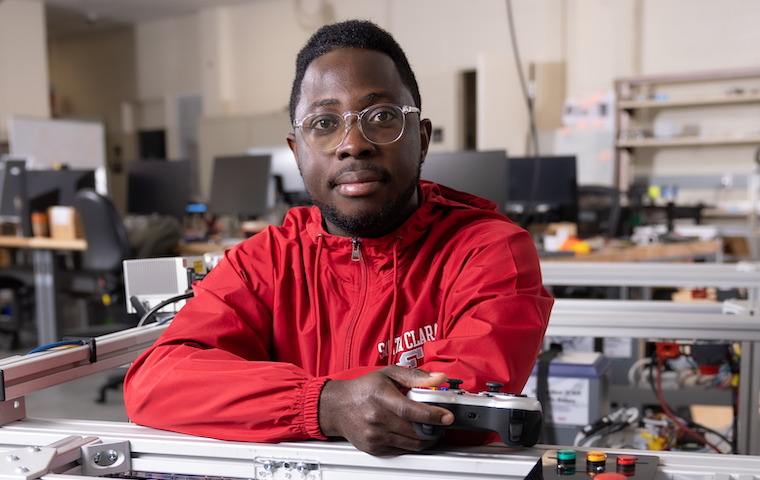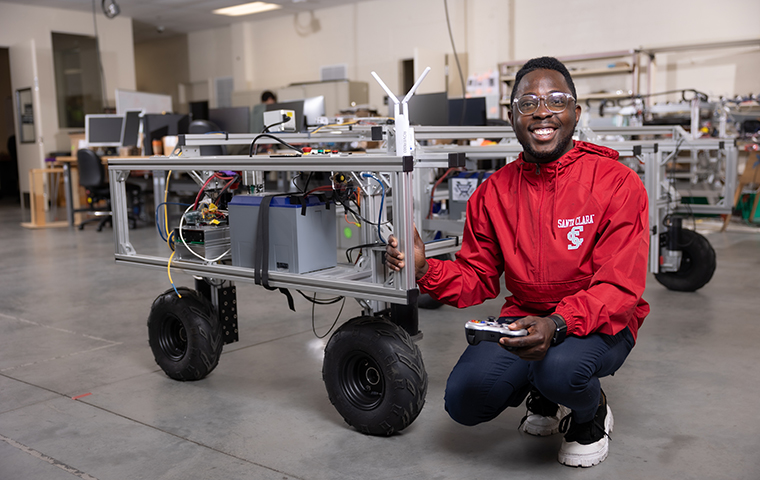
A Whole Different Idea of Engineering

With the right kinds of technology investments, Nigerian-born Michael Aboh M.S. ’23 can envision a brighter agricultural horizon for his homeland, which is losing rural youth to cities offering better-paying jobs. “We have fewer people going into agriculture,” Aboh says, “and this is going to be a problem in the near future.”
Automation could increase the productivity of farmers, he says, particularly the smaller-scale farms. Agricultural robotics, for instance, would optimize farm crop productivity for Africa’s most populous country, the world’s largest producer of yams and cassavas, among other produce. “That’s what I want to tackle,” says Aboh.
It’s also what inspired him to apply to Santa Clara's School of Engineering, where he started a Master of Science degree in robotics and automation in 2021. Aboh was the first student admitted to Professor Chris Kitts’ newest program and will graduate in June.
Under the guidance of his mentor Kitts, the director of the Robotic Systems Laboratory, Aboh has spent the last two years honing his knowledge and abilities in a variety of projects. In particular, he's worked on developing collaborative capabilities for the lab’s autonomous agricultural robot, or agbot. Already being tested at a San Jose farm, SCU’s agbots—with the right tool attachment—can autonomously navigate crop rows, carrying out operations like harvesting and planting. With multi-robot capabilities, farm productivity and efficiency is expected to skyrocket.
The skills and concepts Aboh has absorbed here have been so invaluable that Tesla Motors has a full-time job waiting for him after graduation, when he will begin focusing on the manufacturing side of the electric carmaker’s sophisticated operations in robotics and automation. Aboh couldn’t be happier. As he says, “Silicon Valley, and Santa Clara, is the best place to get this experience.”
We sat down with Aboh to talk about his love of engineering, his journey to Santa Clara, and how his time here has inspired his dreams.
When did you recognize you had an engineering bug?
I was four or five years old watching TV with my brother, and I remember wondering, ‘How are we able to see people inside the TV? Maybe there’s something inside.’ So I took our TV apart, and I looked at the components and the wires. It was pretty disastrous because I broke the TV. My mom was really mad, but my dad helped me put it back together. He just told me that whenever I had those kinds of questions, to explain it to them first, before I did anything. Then, during high school, I was really good with math and physics; I was very interested in how things work generally.
What led you to robotics?
In my last year of college in Nigeria, where I was studying mechanical engineering, we were assigned a final project to design and build a robotic vacuum cleaner. It was challenging, because in robotics, you’re not just a mechanical engineer, you’re also an electrical engineer and sometimes a programmer, too. Immediately after that, I knew this is what I was going to do and what I was passionate about. So I looked up opportunities to study robotics at a graduate school outside the country, because most Nigerian colleges at the time lacked the resources for robotics as a specialization at the grad school level.

SCU’s agbots can autonomously navigate crop rows and carry out operations like harvesting and planting.
Why did you choose Santa Clara?
I talked with a couple of professors from other universities, but I also stumbled upon Dr. Kitts and the Robotics Systems Lab through a YouTube video, and a research paper he wrote about collaborative robotics, which is a topic I had been analyzing. I emailed him and, on our very first Zoom meeting, even though I was on the other end of the world, he was very explanatory, very welcoming. I just felt like this is the kind of supervisor I want to work with. That’s when I knew I was going to come to Santa Clara.
What’s the best piece of advice you’ll take with you?
Whenever I got stuck at some point during a project, Dr. Kitts would always say: “Just go back to the foundations. Go back to the fundamentals and verify the validity of your hypothesis.” That will stick with me. So when you look at a problem, don’t get overwhelmed by the big picture. Every big picture started with a foundation, a fundamental. Once you understand the fundamentals, you can make gradual increases, and gradually those steps will make better technology.
What will you remember most about your experience here?
Every single class I’ve taken has given me a whole different idea of engineering, whether it’s been robotics, mechanics, machine learning, or AI and control systems.
There’s a recycling company I interned at where robots help pick up recycling materials from the conveyor belt. But the company lacked a system that could keep track of robot performance in terms of “pick efficiency,” leading to a significant drop in performance without any warnings. This was frustrating because a lot of times, if a robot goes into this state, the recycling robots are shut down until an engineer can fix it. So I designed a little control system device that could keep track of the performance of the robots, and send out an alert to the engineers if a robot was working below a certain threshold, and may be about to break down. It ended up being a big game-changer for the company, and it’s being tested and implemented at other locations. Every single skill I applied there I learned at Santa Clara.
I would also say that it’s a very good thing for universities to be concerned not just about academic life, but how you could be a better person in general. That’s made an impact on me at Santa Clara. I work as a teaching assistant in the Maker Lab, and seeing students come in and helping them as much as they want gives me joy.
How do you view the role of robots?
I don’t think technology is going to replace humans, but it will change the way people work, and make it more efficient and effective. We used to do calculations in our head, then the calculator came along. But people are still doing research in math. Yes, technology will replace some jobs, but a lot of things that are being automated aren’t healthy to begin with. If you’ve been to a recycling plant, for example, it’s not conducive to people’s health. Putting robots in there removes the need for humans to be in that kind of environment. I think the world is going to shift towards people working more with their brains, rather than hands-on strength.